Author: jeanyveshuwart
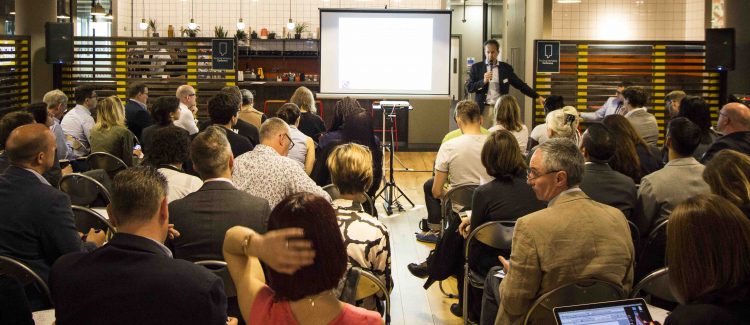
The second year of The Social Workplace Conference in London opened with high spirits, leading a day of engaging talks, inspiration and of course, that wonderful feeling of community.
Pier Mucelli from eOffice kicked off the day discussing the origins of coworking and the pioneers that lead the way in distinct classifications such as public spaces and members clubs. The first coworking spaces in the world were launched in the early 2000’s. The format has since grown and now includes branded incumbents WeWork, our special hosts for the event.

Whilst the likes of WeWork, Google Campus and Regus, to name but a few, are globally recognised brands in the sector, they collectively share only 15% of total market share, meaning that 85% of the market share is absorbed by independent providers. Giving a lot of opportunity for these independent providers to shape the culture and purpose of their co-working outfits.
“Distilling a community of talent”
But why are coworking spaces becoming so popular? Hillary Deppeler, Brand Marketing and Partnerships Director for WeWork EMEA, explained that the demographic shift of the way people work and want to engage means that the workplace must become vibrant places that provide connectivity, allowing members to focus on their work by taking care of the common facilities. Members are increasingly connecting through the WeWork app where they can post jobs, seek skills and meet new people in multiple directions, whilst leveraging the USP of their global community that has evolved organically. 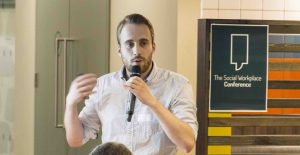
Talking about community, the audience was awed with Sarah Turnbull from Bootstrap London who is creating a community by doing good. She illustrated the the story of doing good through selecting occupants with social and community based impact. Infectious inspiration that reminded us of how so many lives can be impacted by the communities we wish to build and the talents that can be nurtured within these communities.
“Building a community by doing good”
Is coworking a popular mode only for freelancers and millennials?!
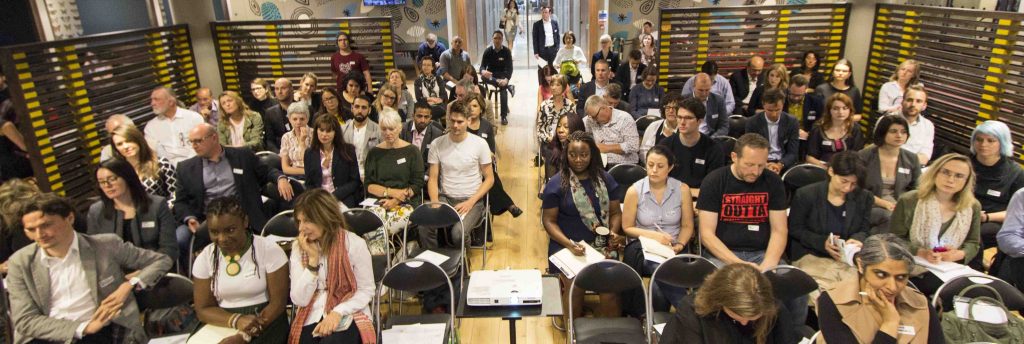
According to JLL’s research on a new era of coworking, this is not the case. As corporations vie to retain talent and facilitate innovation, the real estate firm has seen increasing demand from corporates to utilise this work mode for its personnel. This can be achieved through various models, explained Karen Williamson and Maciej Markowski, from JLL : internal collaboration, coworking memberships and internal / external coworking spaces, with various benefits and downsides to each. Rob Fitzpatrick, Confluence Partnerships, highlighted the design of the workplace and its impact on the psyche, adding to the need for corporates and organisations to design environments that are conducive to the productivity, social connectivity and mental health of its workforce.
Highlighting the evolution of the workplace and architectural design of workspaces throughout time, Oliver Marlow from Studio Tilt succinctly argued that space, creativity, community and innovation are symbiotic by-products impacted by the physical environment. Creativity and collaboration as social capital can be fostered in environments where emotional intelligence and flow form a part of the design and community building process. Mischa Schlemmer emphasized the need to be authentic in order to build a community, but to also engage and serve the community in order to attract and retain members or for corporates, their personnel.

As if that wasn’t stimulating enough, the afternoon workshops were engines for thought and discussion. Followed by a heated debate on the closing panel, where our American counterparts, Frank Cottle from Alliance Virtual Offices and Liz Elam from GCUC finally agreed that community is a feature of a coworking space, and needs constant development, maintenance and aligning values. Community was a much talked about topic for the day, highlighting the humanistic need to belong and relate to others. This human characteristic has not changed in millennia. As we enter a new age of industrial revolution, the future looks like a great forecast for community not only in our personal lives, but also in the workplace.
Written by Letitia Seglah on June 15 2016
Pictures by Deskmag
Find the different presentations here below or here.

The office moves towards a ‘clubhouse’, a space which acts as a hub for soaking up the company DNA”, Chris van Houdt, PROOFF Design
When we imagine the future of work a lot of things come to mind: Smart cities, co-living spaces, even “officeless” workspaces”. Adopting similar ideas that came from movements like Bauhaus, architecture in the workplace aims to gain a deeper understanding of society and technology’s relationship to design.
To find out more about those designers that are influencing the way we imagine the future workplace, we reached out to PROOFF, a Dutch agency that “provides solutions for the new paradigm of work”. We spoke to Chris van Houdt about the exploration of activity based working by developing furniture concepts.
Hi, Chris. Why is it important for design to incorporate variety into its practice, and what does it bring to the overall result?
Working with different design studios means that we can really focus each designer’s own unique qualities and skills, as well as their specific field of research. Having one designer to create the whole collection wouldn’t generate the same outcome, as each one brings something else to the table. Together, we have created a collection of 10 furniture solutions, each product representing specific needs of the workspace.
Your designs are “intimate” but made for “public space” can you tell us a bit more about how that works?
It’s important to carefully research the current and future needs of the workspace, translating these into furniture concepts, carefully creating prototypes, fine-tuning and finally getting the products ready for production by our selection of highly skilled craftsmen. In our case, the products are each designed with a specific solution in mind. Making life and work easier whilst boosting productivity, wellbeing and innovation in the office.
As we are looking to explore the role of design in the workplace, how do you see this playing out?
When you look at the shift towards open plan offices, started some years ago, the ambition that companies and interior designers once had (having the workforce all in one big open space will make them collaborate more and have the company be more productive, plus reducing furniture costs because of sharing workspaces) is, in most cases, not being achieved.
Staff often experience the open plan office as chaotic, not being able to focus or have a private conversation. In short, workspace design, doesn’t accommodate different styles of working and the needs of staff. Carefully designed furniture and workspaces can combat that and also play a big role in workspace wellbeing.
What is your take on the contemporary design often found in office space today?
Today, the role of architects and (furniture) designers is really about gathering information about the workspace they are designing for. Transforming these details into a workspace and furniture that gets the best out of its users. Amplifying the productive, innovative and collaborative atmosphere at the office. Architects and designers are continuously trying to find a balance between what they envision and their client needs.
In your opinion, what types of design works best with the needs of contemporary workers?
We see the office moving more towards a ‘’clubhouse’’, a space which acts as a hub for soaking up the company DNA. A home-base like structure, where staff can come in and out like a beehive. Today’s workers are looking for a workspace that lets them choose how they can work best, mentally and physically. They want to pick and choose their favorite spot to do focused work, make a phone call, have a private chat and collaborate with their team. This flexibility and ‘’keep moving’’ strategy enables staff and thus businesses grow.
Workspace design needs to facilitate this and the design of the workspace needs to strengthen the company DNA, think colour, material, structure based. This is where architects, interior designers, and workspace consultants play a pivotal role, as they are able to research, strategize and envision a workspace that works best for each client and their staff. And this is where furniture design comes into play. Their furniture solutions chosen need to amplify the strategy the workspace creator has in mind.
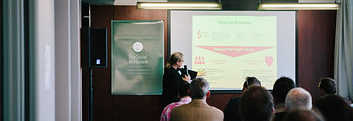
According to the Global Coworking Survey, co-produced by SocialWorkplaces.com and Deskmag, close to 80% of the coworking spaces in the UK are planning to expand in the near future.
For almost half of the recorded spaces, this expansion would include establishing new locations.
From our results, we also found that surface space is more substantial in the UK : 9.235 sqft on average in Britain as opposed to 7.955 sqft globally.
UK coworking spaces’ capacity is on average 12% higher than the average in the rest of the world, with 43% of the spaces hosting more than 50 workers, as opposed to 38% worldwide.
Details, statistics and data on coworking in the UK can be downloaded here below :

Established in 1997, Towergate Insurance has set itself apart from other agencies by providing specialist insurance products to sections of the market that require out-of-the-ordinary cover, such as skydiving insurance.
Towergate caught our attention when they published an infographic titled: An Infographic guide to coworking for Businesses. As we explore the future of the workplace, coworking is a major part of the evolution of the workplace, and we wanted to now a bit more about how traditional business sectors, like insurance, experience coworking. We caught up with Nick Colman and Kira O’Sullivan from Towergate to find out more about their experience with coworking and the changes in the workplace that are affecting some of the most traditional businesses today.
Towergate employs experts in various fields of insurance. What are some of the major changes you have seen taking place in contemporary company culture?
Our offerings change to reflect and to also address the constantly evolving business insurance requirements.
One area of change has been with regards to more and more mobile businesses, which usually have employees who work flexibly between different offices, and also those who use coworking spaces. These people all require coverage that meets their needs while move, for which we’ve created specific insurance coverage.
Do Towergate employees work in a coworking space?
Being a large company of over 4,000 employees, we don’t work in coworking spaces. However, we have increased the number of hot desks throughout our offices, as more and more employees work in between offices and often interact with different teams. We have break-out areas in our offices that also allow teams to get together and bounce ideas off one another in a space more conducive to creativity.
The majority of our working days are spent at the office, however we also do try to make the most out of our local area. For example, we might go to a local coffee shop for a quick meeting. We also organize team days at dedicated spaces such as ETC venues and attend seminars and talks, which are often held in coworking spaces.
Your infographic, “A guide to coworking for businesses” touches on a topic that is at the forefront of discussions regarding contemporary workspace culture. In your opinion, will coworking, or flexible workspaces, be an integral part of the future of big business and corporations?
We see both the economical and creative value in coworking and flexible workspaces. Workspace is certainly at a premium in urban areas, and as we’ve seen at Towergate, which is also likely the case with many national and international companies, employees often work with those based in different locations and often need to be more mobile.
As a result, these employees don’t need a desk in one fixed location. Coworking and flexible workspaces also enable employees to meet individuals that they may not work with directly, which should encourage innovation and a more cohesive company culture.
Have these workplace transformations changed the insurance sector?
Being a relatively “old school” scene, the insurance industry hasn’t yet been fully impacted by the workplace transformation. However, as mentioned earlier, we do see a change in the way employees interact more frequently with those based in different locations. Flexibility fosters creative thinking, cross-team collaboration and a more pleasant work environment.
Do you think it’s more difficult for more conservative businesses (like real estate, banking, etc.) sectors to adopt?
Yes. As much truth as there may be some stereotypes, the misconception that flexible workspaces are only suited to trendy start-up style companies just isn’t the case. However, change takes time and well-established businesses often just need more time, and, particularly in the case of banks and insurance companies, to fully understand the cost benefits of such changes!
According to your infographic, 75% of the workforce will be comprised of Millennials by 2025. What does this mean for the future of older workers?
I don’t see any particular reason as to why older workers need to struggle. It all comes down to understanding the tools that you are working with. That can sometimes be a struggle but isn’t necessarily a generational issue.
Nobody is born knowing how to use Twitter or Excel! Those who are open to learning and embracing progress should have no difficulty with change – and this applies to all ‘change’, including the general move towards more flexible working environments.

Workplace Insight is one of the most widely read magazines concerning “the built environment”. We spoke with Insight’s publisher, Mark Eltringham, to get an idea of what the future of work looks like from the perspective of one of the biggest magazines covering the movement today.
You have been working as a writer, editor and marketing professional for over twenty years, what are some of the major changes you have witnesses in the workplace from this perspective?
One of the interesting things about the sector is about how much it has changed and yet also how little. Many of the debates that rage now about things like flexible working, wellbeing, inclusive design, collaborative work and making the business case for office design have been with us for decades. At the same time, we have seen the office’s role shift dramatically, not least in becoming just one of the spaces in which work gets done The workplace now is both physical and technological.
In terms of the physical design of spaces, the most important change has been the growing irrelevance of the desk. Just as people now work increasingly at home, in cafes and wherever, so offices now look more and more like those spaces. People still work at desks, but not as much as they did and they certainly don’t work on vast workstations with tons of paper and huge desktop computers. That is why it’s interesting to see sit-stand desks gain such relevance.
As a publisher, why is it so important for us to have written commentary and regular discussion about the workplace?
The important thing is to be part of a community. Traditional journals still have a role to play but they’re different beasts to what happens online. That is where the dialogue happens and it is where you discover the dynamics of a sector. One thing that I think goes underappreciated is just how influential this world is, because when we carry out our analyses of where people go to for information, we always discover that there are key individuals who command a bigger audience than the traditional trade media. It is these communities that shape the world.
Workplace Insight has published numerous case studies outlining developments from space design to the role that real estate plays in the future of work. Based on these studies, and your own experience, how has the role of the real estate industry transformed in relation to the contemporary workplace?
Up until recently, I don’t think it has. It has always had difficulty adjusting its business model to a rapidly changing world. In my view, the dead giveaway is its continuing adherence to the idea of space standards which are a relic of the days of one person and one desk. They are still useful, but increasingly irrelevant as offices become more about the utilisation of space and less about occupation.
I know the issue of lease lengths continues to be a challenge but I think it is the idea of space standards that suggests they are at odds with the realities of what firms – especially startups and TMT firms – want from offices.
I know the issue of lease lengths continues to be a challenge, but I think it is the idea of space standards that suggests they are still at odds with the realities of what firms, especially startups and TMT firms, want from offices.
This is the gap now filled by firms like WeWork who understand that a growing number of firms consume offices as a service.
From the perspective of Workplace Insight, what are some of the needs of today’s workers? Are people becoming more satisfied with the way that they work, or are there still changes that need to be made? If so, what are they?
If anything, people appear to be less satisfied. You can speculate as to why that might be, but my guess would be the incursion of work into their once free time and the fact they often do this willingly and sometimes don’t acknowledge it. There is also a growing uncertainty about jobs and pay, alongside mundane working environments, an inability to escape the noise and intrusions of their coworkers, lack of opportunities, lack of flexible working in addition to the physical and psychological impact of modern working life.
We have come a long way from the days of workers holed up in their cubicles, and more and more offices are choosing the open space plan. What do you think was the catalyst for this change? Do you think the coworking movement has played a major role in how office space is designed today? If so, why is that?
Open plan is popular because it makes good business sense. I know firms like to sell it on the basis of collaborative work which is probably true in many cases, but their main drivers are clearly that it is cheap and easy.
I think coworking’s day is yet to come in terms of its influence on mainstream office design, although that will change very soon.
In addition to coworking becoming increasingly popular, many major corporations are adopting the coworking model as well. Do you consider these changes in the corporate workplace as effective, or do you think that larger enterprises still have a long way to go when it comes to changing company culture for the better?
I think I would have to challenge what is meant by “better”. I don’t think there is a continuum of evolution towards an idealised working environment and culture. What is exciting is the fact that firms have the choice of more forms of working and workplaces, even though many still may not acknowledge the fact and may not know how to match that up to their culture and ambitions.
Workplace Insight often covers design and the role it plays in workplace wellbeing. Can you tell us a bit about some of the trends you are currently seeing in workplace architecture? How does design encourage wellness in the workplace? And on the same note, in what ways does design improve productivity?
Design doesn’t improve productivity on its own. People can be happy and productive in badly designed offices and unhappy and ineffective in well-designed offices. The important thing is to create a working culture that meets peoples’ needs and then design a workspace that expresses that culture and fosters productivity and happiness.
I would make a similar point about wellness. Designed solutions are often important but secondary to managed and cultural solutions. The perfect example is sit-stand desking, which is a great product but only effective when people are encouraged to stand and move in the first place.
Many workplaces now have their own “third spaces” such as cafes, relaxation rooms. Do you think that this a positive change? Or do you think it blurs the line between work/life balance?
It’s been around for some time, and it’s undoubtedly positive as it allows people to shift their focus, work in a different way and even take time out. Whether this affects their work/life balance I have less of an idea. I think that it is something that we have to choose.
We are hearing rumors that the workplace of the future will be “office-less”. Do you think that we will one day be without a physical workplace? If so, do you think that this would benefit workers, or is having a meeting point essential to creating company culture and productive employees.
I’ve been hearing about the death of the office for as long as I’ve worked in the sector and it’s as much nonsense now as it was twenty years ago. The proof is in the lack of Grade A office space in major cities and also in the decision by companies like Google, Apple and Facebook to invest in huge new office complexes.
The reasons are both practical and linked to human nature. A lot of research has been done into what makes people happy, productive and collaborative, and a lot of it is linked to being around other people and feeling part of something. That is not to say that the role and emphasis of the physical workplace haven’t changed, but offices will be with us in one form or other while we remain human.
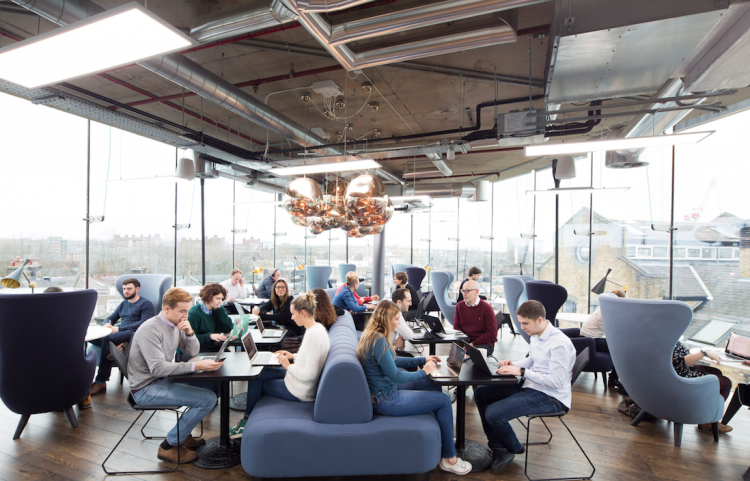
We caught up with Vanessa Butz, Managing Director at Interchange, a new full-service coworking and events space based in the heart of Camden, London, which provides companies and entrepreneurs with the ideal framework for creativity and growth. Before working with Interchange, Vanessa helped build up the community at Factory, one of Berlin’s largest tech spaces to date.
London is a major business center and also home to numerous large corporations. Would you say that your space is marketed to this crowd? If so, why?
Interchange is mainly aimed at creative, fast-growth companies, who are looking for an inspiring working environment that will support them from startup through to scale-up. However, we have also had interest from companies of all sizes, including major corporations, a number of which have moved specific innovation teams into our space.
Would Interchange be defined as a facility, service, or a hospitality provider? If so, why is that?
It’s is a mix of all three really. Interchange is a coworking office, as well as an events and networking space. We also provide our tenants and visitors with a range of other facilities, as well as access to advice and support.
Furthermore, the main Interchange sites are located at the heart of Camden, which has over 28 million visitors a year, and is London’s third largest business district, after the City and Westminster. The location helps our tenants to stay connected via the central location and great transport links.
What types of members do you have so far, and are any of them new to the open workspace model? If so, how are they adapting to the concept?
We have a wide range of members, spanning industries such as design and marketing, healthcare and fintech, including accelerators and VC companies. Some are new to the open workspace model and some have moved from other coworking spaces, but all are adapting well. Ultimately it’s about finding the right fit.
Some of our current members include a healthcare startup, Doctify, who help to connect patients to healthcare professionals. We are also home to Osper, a mobile banking platform for young people, and IncuBus, which is a pre-accelerator for startups.
Has it been challenging to attract people to the space? And what do you think needs to happen in order to educate potential members about the benefits of Social Workplaces?
We generally feel that in London especially, that there is high demand for shared workspaces that meet the needs and expectations of potential tenants. Most companies and individuals, particularly startups, have a good understanding of why it’s beneficial to work in shared spaces, including the access to support, networking opportunities and inspiring atmosphere they can provide.
When you were developing Interchange, was design a major consideration? What types of design influenced the process? For example, did you focus on different types of third spaces such as a restaurant of a café?
One of our buildings, ‘Atrium’, is still under construction, but once complete, Interchange will offer over 84,000 square foot of coworking space. We will also have a number of exciting facilities available on-site, including a restaurant, cafe, bar, and gym.
The Camden buildings have been designed by DRS under the creative direction of Tom Dixon, an acclaimed British designer whose past work includes Shoreditch House and Mondrian Hotel.
In your opinion, why do you think that corporate players are now looking to leave their offices? What are they missing in the more traditional environments ?
We’ve definitely seen a trend over the last few years of larger, corporate companies becoming interested in what startups are doing and the way in which they work, particularly in relation to innovative business practices and new technologies. Coworking is a big part of this, as it encourages openness, creativity and collaboration. Interchange provides a framework for these elements and is therefore an ideal space, whether for a one-man startup or a satellite team of a larger company.
Do you provide any additional services for your members? Have you curated these programs to certain types of professionals, or are they more open?
As part of the wider Interchange offering, we run regular events, workshops, talks and training sessions from our events space, which anyone can attend. Additionally, our tenants also have the unique opportunity to establish their own retail space in the iconic Camden Markets, from which they can showcase and sell their products.
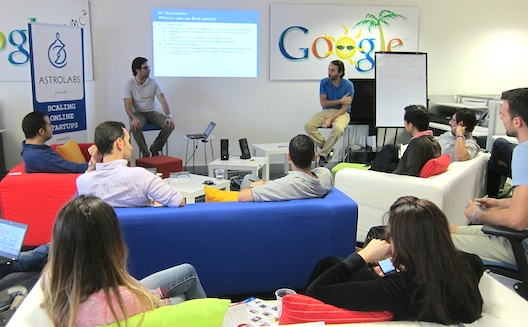
In 2013, Louis Lebbos and Muhammed Mekki, the two founding partners of AstroLabs, organized SOS, known in full as, Scaling Online Startups. The training program included more than 130 startups in the MENA region, from the United Arab Emirates to Qatar, Kuwait and also up to Saudi Arabia.
The project gave them a deeper look into the entrepreneurial scene in the Middle East, causing them to realize that that there was a need for social workspace and technology hub in the region. Their vision was to create a platform from which a strong community of entrepreneurs could gather and support one another to develop disruptive businesses.
We spoke with Tiberiu Iacomi, Tech Hub coordinator at AstroLabs, about the development of their space in Dubai. Since their opening in April 2015, the first Google-partnered coworking space in the MENA region with more than 60 startups with founders from 27 countries.
Hi, Tiberiu. What does the current entrepreneurial scene look like in Dubai?
There is an exponential growth in the number of tech startups in Dubai and entrepreneurs are looking more towards the potential of developing their businesses, both in the region and on a global scale. So far, AstroLabs has received more than 400 applications since their official launch, and some of our events, like Startup Weekend Dubai, had 100+ participants who are all emerging entrepreneurs.
How did you come to decide to partner with Google?
Given that entrepreneurs in Dubai and throughout the MENA region now consider digital technologies as the key to scaling up their startups on a global level, the partnership with Google for Entrepreneurs was a natural step. The fact that GFE has developed a network of more than 20 Tech Hubs all over the world (US, Europe, Asia, Africa) as well as a series of training programs such as the Silicon Valley Blackbox Connect or the GFEX (GFE Exchange Program) is giving the startups based at AstroLabs access to a global network.
Last but not least, within its mentorship network, AstroLabs has attracted 12 mentors from the Google MENA office in Dubai, who are experts in a wide range of digital topic from analytics to advertising and up to mobile development.
Google is a major pioneer of the transforming workplace, has that influenced AstroLabs?
Definitely. One is able to see a series of the Google principles on workplace design embedded in how the AstroLabs hub was built and also in the way the community of entrepreneurs is shaping itself as one of the most collaborative groups of tech people in Dubai. From the 80-20 approach of dividing work time, and also mixing in relaxation and focusing energy into the multicultural exchange of ideas, the AstroLabs hub is a space that harnesses and enhances brainstorming and feedback across more than 15 industries and between amazing individuals from 27 different countries.
From the 80-20 approach of dividing work time, and also mixing in relaxation and focusing energy into the multicultural exchange of ideas, the AstroLabs hub is a space that harnesses and enhances brainstorming and feedback across more than 15 industries, between amazing individuals from 27 different countries.
What are some of the traits of AstroLabs that ensure success? Does your space incorporate third spaces, like breakout rooms, a café, or is it more focused on team-based office, etc.?
The inspiration of AstroLabs stems from the astrolabe, the navigation tool invented by the Arab people in ancient times, which extends to the modern idea that entrepreneurship can be a successful journey if proper guidance is provided.
The hub has spaces such as the shared area, which is an open space where entrepreneurs can ask for advice or offer feedback to each other. There is also a coffee boutique called 59 Degrees where they can socialize, meeting rooms where they meet with mentors on a weekly basis, the device lab where they can test their websites and apps on a variety of devices and, last but not least, the conference room where they can take part in the classes organized by the AstroLabs Academy on digital topics (ranging from SEO to Google Analytics and up to online marketing) or in events such as the Google Design Sprint or a Youtube Creators’ Day.
Have open workspaces influenced the real estate industry sector in Dubai? For example, in the United States, open and shared spaces play a role in revitalizing neighborhoods. Do workspaces play a similar role in your region? If not, what type of role do they play?
Incubators, accelerators, and coworking spaces are on the rise in Dubai and, as a result, they are impacting the economic and education sectors. First and foremost their impact on a macro level creates a more entrepreneurial society which can be more relevant in the global economy. At a local level, because startups are creating new jobs and new areas of recruitment and learning – considering only startups are based at AstroLabs, one can see there have been more than 100 jobs created and promoted through our Startup Jobs portal on the AstroLabs website.
Secondly, more universities are creating entrepreneurship courses or full degrees while more students with business degrees are inclined to set up their own startup after they graduate. At AstroLabs, we’re seeing an increase in inquiries, applications and, implicitly, startups that are founded by recent graduates from business schools.
As for the impact on the real-estate sector, I believe it’s too early to estimate.
How is work approached in Dubai, is a more traditional 9-5 approach or is the concept of social workplaces widely accepted? What are some of the specific needs of entrepreneurs in the MENA region?
The coworking and open workspace concept is an up and coming trend in Dubai. It is not only accepted, but also embraced by more and more people coming from various backgrounds, from working professionals to freelancers, as well as budding entrepreneurs and full-time entrepreneurs.
The main differentiation point of AstroLabs is that it is a coworking space that is more than a space for its community of entrepreneurs – it’s a meeting point for brilliant minds. It’s also the starting point in the journey for scaling at a global level.
Is there anything that AstroLabs does for their workers that other office providers can’t?
AstroLabs adds knowledge resources, from feedback sessions amongst the entrepreneurs, to mentorship sessions with experts. We also offer classes, workshops, and events on the most relevant business and digital topics.
What types of members do you have? Are they typically self-employed, or from more corporate entities?
All of our members are full-time entrepreneurs dedicated to building and developing their startups.
Why do you think corporations would be attracted to a place like AstroLabs?
Corporations nowadays need to develop an internal innovation engine to ensure they stay relevant in the market. A place such as AstroLabs is a hub where their people can take part in events and courses that can refresh their perspective on how digital technologies can make them better understand their customers and the way new markets and new niches emerge.
What kinds of services do you offer your members?
Due to the partnership with the DMCC Free Zone (which is the largest free zone in the world), we are able to offer licenses to the startups that are selected at AstroLabs, which is an essential point in their development.
More than that, we are creating the collaboration frameworks for the entrepreneurs to establish partnerships, interact with mentors, learn how to shape their business models and, ultimately, participate in pitching events with organizations such as 500 Startups.
How do you envision the future workspace in the MENA region?
Open, definitely. And more than open, open across cities in the sense that entrepreneurs will start sharing more and more their experiences from AstroLabs Dubai across UAE and MENA and outside the region.
Entrepreneurs from AstroLabs have been traveling and working from hubs such as Galvanize San Francisco, Campus London or Campus Madrid so the future workspace in the MENA region is not only an open physical space but also a global virtual workspace.

Globally renowned expert on the impact of the built environment on business performance, Despina Katsikakis, is a major player in transforming how we understand today’s workplace. Interested in the ways in which physical environments affect both user experience and their impact on business, Despina has worked with developers, funds and their design teams on how to “differentiate and future proof award winning schemes globally”. Recently a speaker at the first Social Workplace Conference in London, we spoke with Despina about the ways in which the contemporary office can create all inclusive work environments and why events like Social Workplace are so important to the future of work.
Hi, Despina. You have a lot of experience helping large enterprises, like Barclays, to reinvent their idea of the workplace. What types of projects are you currently working on?
I worked with Barclays to help them understand the best way to utilize space as a way to change behaviors, support innovation, as well as co-creation. In addition to that project, I am doing a similar project with another bank at the moment.
I am also the design curator for a new 1.5 million ft.2 [139.354,56 m2] tower in the City of London. This is a very exciting project as the objective is to design a vertical village, which will be a real-time social network that will embrace the sociability of how we work today. The aim is to create a different model for what a building can offer, from providing a variety of work areas and amenities, as well as a platform for connection and community with places and events that support collision, collaboration, curiosity, and wellness.
An increasing amount of corporations are attempting to adapt this model, but it’s not as easy as it might seem on paper. Why do you think some corporations fail when they try to implement the social workplace into their company?
I think that there are several reasons for unsuccessful adaptation. Number one, there is always a disconnect in large corporations between workspace and what motivates attracting and retaining talent. More often than not, the space comes from a traditional perspective, and the main objective is always to reduce costs without measuring what impact it might have on people’s engagement and productivity.
The times I have seen a social workplace successfully implemented into a corporate landscape is when the senior leadership recognize the role and value that physical space has in conveying the culture and values of the organization. However, in order to make it happen, it requires bringing together HR, IT and real estate in order to create an integrated people-centric experience.
What needs to happen in order to guide corporations in the right direction in regards to the future of work?
There are several elements. When you are helping people embrace something different, you have to get them to understand what they are currently doing.
80 percent of large corporations will still try to provide efficient office space, which will be adequately designed and laid out, but will still assume that people will come in and work at their desk all day long. The reality is that desk space tends to be utilized on average 40 to 50 percent of the time on a typical day. People today work in a variety of locations, and they are not always sitting at their desk, thus the space remains under utilized and does not support collaboration nor inspire employees. When in these situations, I ask what it is the company is trying to achieve and try to hold up a mirror to reflect back to them the actual messages that their current space communicates.
By creating awareness, companies can understand the disconnect and clarify what their message should me. Addressing changes in the physical environment is always aligned with guiding them through a process of creating the right culture and behaviors to support their business. Space cannot just look different it needs to also feel different through the way people actually work, interact and engage with one another.
How has the development of Social Workplaces changed the way that corporations value and find talent? Have there been some setbacks, i.e. difficulty finding appropriate employees?
I think the issue with talent is always independent from the economic cycles. Whether there is a crisis or not, organizations are always looking for talent, but what has shifted in the last few years is that employees want to have choice and flexibility, as well as authentic sociability and a sense of well-being. For that reason many individuals are now choosing not to work for big corporations because they have the flexibility to fulfill a variety of roles. Thus, it has become much more difficult for employers to access talent, so now they need to embrace a dispersed talent network which is not hierarchical but rather more reliant on skills and open sourced innovation.
Like major corporations, has this transformation affected the real estate sector? Are there ways that they can adapt and make space more readily available? What do they need to do to meet the needs of contemporary lease agreements?
Yes, definitely. Much of the current innovation taking place in the workplace comes from outside, like coworking environments, and the real estate industry recognizes that. Corporate occupiers are now looking to increase their real estate flexibility and access talent in different ways. Also, the same organizations will want flexibility through ‘spaceless expansion’, which is interesting because it means that from a real estate point of view, they will need to move away from traditional fixed leases and space in order to embrace flexible and on-demand space.
The workplace transformation is obviously benefitting businesses and employees who are already somewhat established, but what about those who do not have access to these types of resources? Do you think that Social Workplaces could create an equal playing field for various demographics?
I do. This makes me think back to Edu Forte’s presentation at the Social Workplace Conference about shared workspace. The idea that we are working towards creating places where you can bring together various individuals and generations to work side by side and create community creates more room for mobility and is very exciting.
It is always talked about that Millennials want flexibility, but so do Baby Boomers. We need to re-tap into these types of work experiences that inspire and attracts those from all demographics and age groups.
What was your impression of the first Social Workplace Conference? How do you see the conversation continuing? And what would be the necessary steps to ensuring we build a workplace environment that actually meets these needs?
The first conference was really good. Events like Social workplace are hugely important in terms of educating corporate occupiers, investors and users of space, of what the opportunities are. Also, the ability to hear these experiences first hand is very rich.
I think that we are at an amazing time of innovation and change in terms of rethinking how we live and work today. We have more opportunity to collaborate and co-create new environments, and the conference plays an important role in pushing these changes in the workplace today.
Amanda Gray

Last Friday saw the inaugural Social Workplace Conference, an event that aims to create content and bring insight based on “strong models taking root in community managed workplaces to a wider audience of professionals from the real estate industry and corporate world”. Experts from the fields of design, coworking, finance, and corporate innovation all gathered in London’s design-centric shared office space, The Office Group, for a productive day of talks and workshops.
The Social Workplace is shifting the way we view physical space
Presentations addressed topics such as a non-traditional user-centric approach to architectural design, which Oliver Marlow from Studio Tilt, a design and architecture studio known for its unique codesign methodology, explored in relation to the current systemic changes taking place in the workplace.
Despina Katsikakis, of Barclays Corporate Real Estate, brought to light some important statistics taken from a recent Gallup study, which states that 80 percent of office space still hasn’t changed over the past 10 years, thus continually limiting choice and control.
Despina’s presentation offered alternatives to addressing how to deal with these setbacks, by comparing contemporary office space to cities. Like the urban environment, “the office of the future should act as a social condenser that is exciting, spontaneous, and non-linear”, she explained.
Social capital matters more than monetary gain in today’s work culture
The general feedback from most participants was focused on an interest in the developing relationship between the corporate and coworking world. Alex Hillman, founder of Indy Hall, a successful coworking space based in Philadelphia, brought home the point that the Social Workplace Conference is a chance for people working in various industries to hear each other out and work towards actual change, not only in their offices, but also in their communities.
Edu Forte, founder of Betahaus Barcelona, discussed the process of cocreation. Through this process, the coworking model allows room for the community to develop the physical space as well as programs that meet their needs.
Stefan Kiss, who has been working in the office furniture industry for over 25 years, and Séverine Blanchard-Jazdzewski , executive of the Orange Digital Transformation program, brought up several point as to why corporations today might be struggling. Stefan discussed the relationship between design and the “human factor”, which he believes once more harmonious, will help transform the current workplace. As for Séverine, she talked about the ways in which companies can meet the need of their employees and their ultimate goal of transforming Orange into an incubator for new collaborative workspaces.
What does the future hold?
The Social Workplace wrapped up the day by giving attendees that chance to interact and participate with the speakers. Several workshops were given, tackling topics such as “How to create value from the social workplace model: Programming, events and cross-fertilisation to ignite culture”, led by Simon Pitkeathley of Camden Town BID.
The Final panel, which was led by Kursty Groves Knight, featured Tom Day, from Travel Tech Lab, Steve Pette of Central Working and founder of London’s Bow Arts, Marcel Baettig. As Kursty is an expert in helping organizations to cultivate progressive cultural and physical environments, the panel reflected on the day’s events, discussing everything from catalyzing a community, to monetizing the workspace through partnerships that work with one’s personal philosophy.
Overall, attendees expressed their excitement in regards to future events. As conference goers headed down the bar for a bit of wine and networking, Alex Hillman of Indy Hall, reflecting on the conference, remarked: “The Social Workplace conference marks the beginning of a conversion that needed to be had, but the most exciting part is what comes next”.
Presentations from the conference are available on Slideshare and also Linkedin.
Amanda Gray
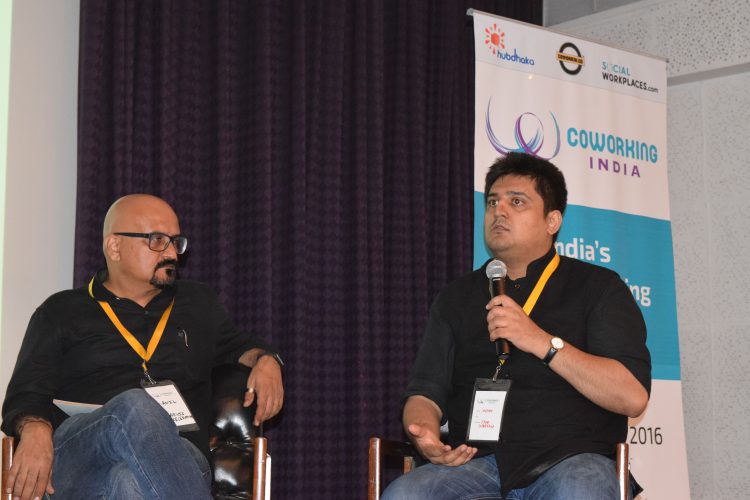









Recent Comments